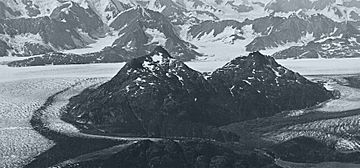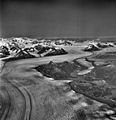Great Nunatak facts for kids
Quick facts for kids Great Nunatak |
|
|---|---|

Aerial view from the south in 1934
|
|
| Highest point | |
| Elevation | 3,652 ft (1,113 m) |
| Prominence | 1,952 ft (595 m) |
| Isolation | 3.33 mi (5.36 km) |
| Geography | |
| Location | Chugach National Forest Valdez-Cordova Borough Alaska, United States |
| Parent range | Chugach Mountains |
| Topo map | USGS Anchorage A-1 |
Great Nunatak is a tall mountain peak in Alaska, United States. It stands about 3,652 feet (1,113 meters) high. You can find it about 21 miles (34 km) west of Valdez. This mountain is part of the Chugach Mountains.
Great Nunatak is located very close to the end of the Columbia Glacier. It is also about 11 miles (18 km) southeast of Columbia Peak. The land around it is managed by the Chugach National Forest. This mountain is about 2.2 miles long and has a second peak that is 3,412 feet high.
Naming the Great Nunatak
The name "Great Nunatak" comes from Grove Karl Gilbert. He was a geologist who worked for the United States Geological Survey (USGS). In 1899, Gilbert was part of the Harriman Alaska expedition. This group explored the area where the mountain is today.
Gilbert thought this mountain was the biggest nunatak in Alaska. A nunatak is a mountain peak that sticks out above a glacier or ice field. In 1902, he wrote about it and called it "the great nunatak."
The mountain's name became official in 1975. This was decided by the United States Board on Geographic Names.
No Longer a Nunatak
Even though it's still called Great Nunatak, it's not really a nunatak anymore. This is because the Columbia Glacier has been melting and shrinking.
In the past, the glacier almost completely surrounded the mountain. But now, the ice has pulled back. Water from Columbia Bay has replaced the ice on the north and west sides of the mountain. So, it's no longer a peak surrounded by ice.
Climate Around the Mountain
Great Nunatak is in a subarctic climate zone. This means it has very long, cold, and snowy winters. The summers are usually mild.
Weather systems from the Gulf of Alaska hit the Chugach Mountains. This causes a lot of rain and snow to fall. Temperatures can drop below −20 °C (–4 °F). With wind, it can feel even colder, below −30 °C (–22 °F). This cold climate helps the Columbia Glacier to exist near the mountain. The best time to visit or climb Great Nunatak is usually from May through June.
Images for kids
-
Great Nunatak in lower right corner, 1993. (Columbia Peak centered)







